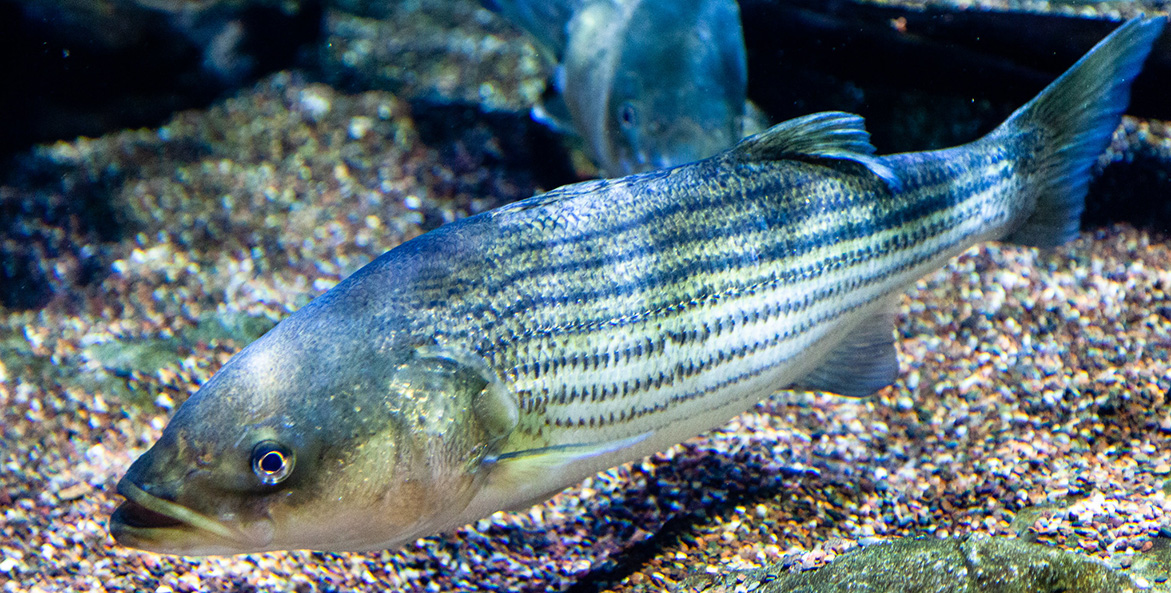Signs increasingly indicate that something is not quite right for striped bass, one of the most revered fish in the Chesapeake Bay and along the Atlantic Coast. In this in-depth series, we examine how a potent mix of fishing pressure, invasive predators, changing climate and habitat conditions, and disease is impacting the population—and what can be done to help.
This commentary was first published June 18, 2024 on bayjournal.com, the website of the Chesapeake Bay Journal.
There’s a shift happening in Chesapeake Bay angling.
“People are pivoting, and they should be,” said David Sikorski, executive director of the Coastal Conservation Association in Maryland. “It used to be all stripers all the time. I find now more people view angling as an experience on the water, versus needing to target an exact species.”
Sikorski is worried about the dire state of the striped bass population. Recent years have seen troubling trends—below average numbers for five years straight in Maryland’s juvenile striped bass survey, fewer citation-sized stripers being registered in Virginia, and a steep decline in the Bay’s commercial striped bass catch.
There are many reasons for these trends, ranging from overfishing and climate change to pollution and loss of habitat. But changing fishing habits is the only immediate way to make a difference.
Chesapeake Bay states and the Atlantic States Marine Fisheries Commission have taken action with new regulations. The tough new reality is also being met by a new generation of anglers.
While stripers remain a staple, other species—especially invasives like blue catfish and snakeheads—are increasing in popularity.
“Blue catfish are available in every tributary of the Bay and provide endless recreational angling options, with no limits,” Sikorski said. “They’re attracting new anglers across the watershed all year round.”
While fishing for schoolie stripers is tempting these warm summer days, it’s also when striped bass are most vulnerable. With the right steps now, we can rebuild a healthy striped bass fishery for the future. Anglers can start by giving stripers a well-deserved summer vacation.
About 90% of striped bass caught recreationally are released, according to ASMFC stock assessment data. But a significant number of these fish die, especially on hot summer days.
ASMFC data assumes that, overall, about 9% of stripers that are caught and released will die due to stress. This percentage can be much higher when summer heat causes low-oxygen levels in the water, increasing striped bass heart rates and hindering their ability to swim, find food and fight disease.
To address this, this year ASMFC established a catch-and-release mortality workgroup to explore options to reduce the loss of released fish.
Maryland has also implemented regulations prohibiting striped bass fishing from July 16 to July 31, when striped bass are particularly stressed by high temperatures. The Maryland Department of Natural Resources posts heat warnings when air temperatures are above 90 degrees. The season will reopen Aug. 1 and run through Dec. 10. Anglers may keep one striped bass from 19 to 24 inches per person, per day.
Summer is prime time for catching many other species, including northern snakehead (also known as Chesapeake channa), white perch and yellow perch in the upper Bay and its rivers. In the southern Bay, where salinity is higher, expect to find cobia, red drum, speckled trout and Spanish mackerel.
Blue catfish can be caught in every Bay tributary, year-round. Introduced into the Bay watershed in the 1970s, these catfish have since become voracious predators of beloved native species like striped bass, oysters and blue crabs.
The Maryland Office of Tourism’s Fish & Hunt Maryland recently added a Catfish Trail resource to help anglers target these aggressive and fun-to-catch predators. Many prime catfishing spots are easily accessible from the shore, where you can use basic tackle and cheap bait (try dipping raw chicken in Kool-Aid).
Blue cats also make for a great meal. Unlike other catfish species that are mainly bottom feeders, blue catfish have a more varied diet and are known for their tasty white, flaky fillets. Summer is an ideal time to catch the smaller, younger blue catfish that taste best.
If you do target stripers this summer, there are steps you can take to responsibly fish them. The maximum catch size for striped bass in the Bay is 24 inches, because bigger fish most effectively reproduce and rebuild the population. Older, larger females produce far more eggs and are key to repopulation efforts.
The last time we saw a strong number of juvenile striped bass in the Bay was in 2015. These have grown into the big fish being caught today.
Anglers can help ensure fish survival by practicing safe catch and release tactics, such as using barbless circle hooks, keeping fish in the water and supporting them with two hands if handling.
Sustainable fisheries require long-term forethought and, sometimes, short-term sacrifice. If we want a striped bass fishery in the future, we need to pivot. Let’s give striped bass a summer break.




